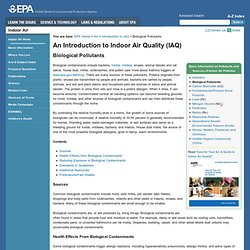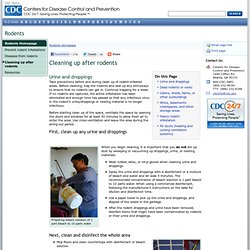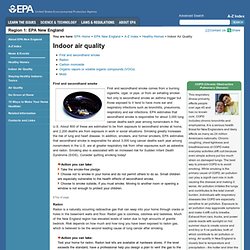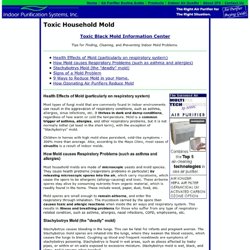

Florida. US Environmental Protection Agency. Biological contaminants include bacteria, molds, mildew, viruses, animal dander and cat saliva, house dust, mites, cockroaches, and pollen (see more about Asthma triggers at www.epa.gov/asthma).

There are many sources of these pollutants. Pollens originate from plants; viruses are transmitted by people and animals; bacteria are carried by people, animals, and soil and plant debris; and household pets are sources of saliva and animal dander. The protein in urine from rats and mice is a potent allergen. When it dries, it can become airborne. Contaminated central air handling systems can become breeding grounds for mold, mildew, and other sources of biological contaminants and can then distribute these contaminants through the home. By controlling the relative humidity level in a home, the growth of some sources of biologicals can be minimized. Contents. Problems With Cockroaches in Schools. The Inside Story: A Guide to Indoor Air Quality. Biological Pollutants in Your Home. Indoor%20mold. HealthNews : Research Identifies Specific Bacteria Linked to Indoor Water-Damage and Mold. Research Identifies Specific Bacteria Linked to Indoor Water-Damage and Mold CINCINNATI—Bacterial contamination in water-damaged buildings has been identified as a potential cause of health problems, including infection and respiratory conditions like asthma.

Which specific bacteria contribute to these problems, however, has been unknown—making it difficult for public health officials to develop tools to effectively address the underlying source of the problem. In a new study, a University of Cincinnati (UC) environmental health research team found evidence linking two specific strains of bacteria— Stenotrophomonas and Mycobacterium—to indoor mold from water damage. The research is part of the U.S. Fungal-factsheet-508c. Cleaning up after rodents - Rodents. Urine and droppings Take precautions before and during clean up of rodent-infested areas.

Before cleaning, trap the rodents and seal up any entryways to ensure that no rodents can get in. Continue trapping for a week. If no rodents are captured, the active infestation has been eliminated and enough time has passed so that any infectious virus in the rodent’s urine/droppings or nesting material is no longer infectious. Before starting clean up of the space, ventilate the space by opening the doors and windows for at least 30 minutes to allow fresh air to enter the area. Pulmonary Home. Stachybotrys chartarum. Stachybotrys chartarum, also called Stachybotrys atra, Stachybotrys alternans or Stilbospora chartarum, is a black mold that produces its conidia in slime heads.

It is sometimes found in soil and grain, but the mold is most often detected in cellulose-rich building materials from damp or water-damaged buildings.[1] S. chartarum was originally described from the wall of a house in Prague in 1837 by Czech mycologist August Carl Joseph Corda. It requires high moisture content in order to grow and is associated with wet gypsum material and wallpaper.[2] Medical and veterinary issues[edit] Health problems related to this mold have been documented in humans and animals since the 1930s;[3] it is also considered a likely candidate for the Biblical condition mistranslated as "leprosy", tzaraath.[4] More recently, S. chartarum has been linked with so-called sick building syndrome. However, the link has not been firmly established in the scientific literature.[5] Detection[edit] See also[edit] Mycotoxin. Can copd be caused by mold spores? EPA New England Healthy Homes.
COPD (Chronic Obstructive Pulmonary Disease) This respiratory illness primarily affects people over age 45 and has no known cure.

COPD includes chronic bronchitis and emphysema. It is a serious health threat for New Englanders and likely affects as many as 24 million Americans nationally. Chronic coughing, chest tightness and breathlessness of COPD make everyday activities diffi cult because even simple actions put too much strain on damaged lungs. The best way to prevent COPD is to avoid smoking. Action you can take: Early detection can help prevent further lung damage and alter the progress of the disease. Indoor Air. Radon Standards of Practice Learn how the radon standards benefit your work, proposals, call for bids, etc.

Listen to or read this webinar for the latest information on radon industry standards of practice available through American Association of Radon Scientists and Technologists (AARST) .Gary Hodgden, Chair of the Executive Stakeholder Committee for the AARST Consortium on National Radon Standards, Melinda Ronca-Battista, Health Physicist currently at Northern Arizona University in the Institute for Tribal Environmental Programs, and Jani Palmer, Scientist at EPA, Office of Air present this webinar. Radon Leaders Saving Lives Leaders from The Conference of Radiation Control Program Directors, Inc. Radon Gas. A Survivor Story For COPD - Alternative Medicine. Mr. Webster, has had an amazing life, he has been a Newspaper Reporter in England, a Policeman in Malaya, an instructor for the Malayan and Hong Kong Air Force, a Publications Manager in Canada, and if that’s not impressive in itself, Mr., Webster, as also been a script Writer in Hollywood and a Show Producer all over the United States.
Some of his work includes well-known comedies shows and documenters. Today at age 77 one of Mr. Webster greatest accomplishments is in his book, titled “ It Takes Your Breath Away- a survivor’s guide to COPD”. Chronic Obstructive Pulmonary Disease (COPD) puts thousands in the hospital every year and in four years will have taken the lives of 25% of them.
Victoria: Mr. Mr. Victoria: What are the things that doctors don’t tell a patient? Mr. Granite Countertops and Radiation. Naturally-Occurring Radiation: This page contains information about granite and radioactivity in granite.

On this Page: Get e-mail updates when this information changes. Granite Overview Granite is an igneous rock, having been formed as lava or molten rock cooled and solidified over thousands, or even millions of years. Top of page Radiation From Granite Any type of rock could contain naturally occurring radioactive elements like radium, uranium and thorium. Oregon OSHA - Oregon Occupational Safety & Health Division. Maps to OSHA Offices. Reducing Mold Allergies. Toxic Black Mold Information Center Tips for Finding , Cleaning , and Preventing Indoor Mold Problems.

Health Effects of Mold (particularly on respiratory system) Most types of fungi mold that are commonly found in indoor environments can result in the aggravation of respiratory conditions, such as asthma, allergies, sinus infections, etc. It thrives in dark and damp conditions , regardless of how warm or cold the temperature. Mold - General Information: Facts about Stachybotrys chartarum and Other Molds. I heard about "toxic molds" that grow in homes and other buildings.

Should I be concerned about a serious health risk to me and my family? The term "toxic mold" is not accurate. While certain molds are toxigenic, meaning they can produce toxins (specifically mycotoxins), the molds themselves are not toxic, or poisonous. Mold - General Information: Facts about Stachybotrys chartarum and Other Molds. I heard about "toxic molds" that grow in homes and other buildings. Should I be concerned about a serious health risk to me and my family? The term "toxic mold" is not accurate. While certain molds are toxigenic, meaning they can produce toxins (specifically mycotoxins), the molds themselves are not toxic, or poisonous. Hazards presented by molds that may produce mycotoxins should be considered the same as other common molds which can grow in your house.